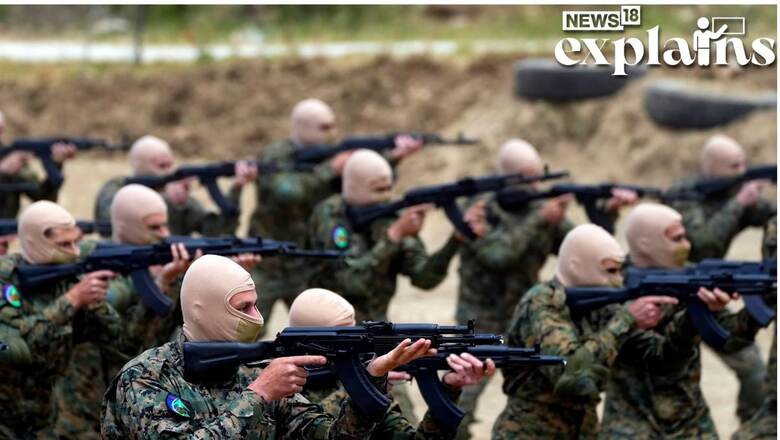
views
The war in Gaza continues for the fourth month in January as missiles, rockets and drones struck targets around the Middle East as the United States, Israel and others clashed with Iran-allied militant groups in the region.
Palestinian militants reported fierce ground combat in southern Gaza, where Israel says its focus has shifted along with the territory’s centre three months into the war. Meanwhile, Israel and Iran-backed Hezbollah, a Hamas ally, have engaged in regular cross-border fire during the war.
Hezbollah announced the killing of a commander- Wissam Hassan Tawil for the first time since October. The Israeli military said it struck Hezbollah “military sites” in Lebanon on Monday.
The Israeli army have also killed a “central figure” in Syria responsible for Hamas rocket attacks, naming him as Hassan Akasha.
Meanwhile, there is an ongoing campaign against shipping in the Red Sea by Yemeni rebels sympathetic to Hamas, which is being attacked by the US Navy.
Israel and its US allies are facing two realities amid the war in Gaza: The Gaza-based Hamas militant group is far from alone as it battles for its survival. And, the US and Israel, by launching an all-out campaign to eliminate Hamas, are also confronting simultaneous attacks from armed militant groups linked with Hamas and Iran.
Here’s a breakdown of the armed groups facing the United States and Israel in the Middle East, a look at what unites some of them and what’s different about each.
Armed Groups Active in Middle East
The US is scrambling to quell attacks by a range of armed groups that are allied to Iran and to each other. They are:
– Hamas in Gaza;
– powerful Hezbollah in Lebanon:
– smaller militias in Iraq and Syria;
– Houthis in Yemen
These groups have escalated attacks on US, Israeli or global targets within their reach since Israel launched its war in Gaza on October 7. The aim of Iran and of the armed groups at large is to aid Hamas with attacks that distract the focus of Israel and the US and making the military, economic and political costs of continuing the war against Hamas too great for Israel and US.
The groups don’t necessarily want further additional escalation themselves, as they don’t stand a chance against the strongest militaries in case of an all-out confrontation. But under the leadership of the late Iranian General Qassem Soleimani, who was killed by the US in 2020, the far-flung array of Iranian-allied militias knitted themselves into a more cohesive network.
Who are the Players?
Hamas
The Palestinian group Hamas is based in Gaza and was founded in 1987 at a time of widespread protests against Israel’s occupation.
It has ties to one of the Sunni world’s most prominent groups, the Muslim Brotherhood, founded in Egypt in the 1920s. Hamas has vowed to annihilate Israel and has carried out suicide bombings and other deadly attacks on civilians and Israeli soldiers.
Hamas seized control of Gaza by force in 2007, the year after it won parliamentary elections there with 44% of the vote. Israel has kept Gaza under a devastating blockade ever since, restricting movement of people and goods in and out of the territory. Hamas receives backing from Arab and Muslim countries, including Qatar and Turkey.
Although a Sunni Muslim group, Hamas leaders have moved closer to Shiite Muslim Iran and its allies over the years. Israel’s far-right government had sidelined any attempt at a negotiated Israeli-Palestinian political agreement, and world attention faded away.
Hezbollah
Hezbollah was formed in 1982 in response to the Israeli invasion of Lebanon, where it is based. The Shiite militant group is one of the strongest members of the Iran-allied alliance, militarily and organizationally.
It took part in repeated attacks against the United States through the mid-1990s, including the deadly 1983 bombing of a US Marines barrack in Beirut, Lebanon’s capital. Its military wing is stronger than the country’s armed forces.
A 2006 war with Israel provoked by Hezbollah’s kidnapping of Israeli soldiers devastated southern Lebanon and Beirut. Many ordinary Lebanese are deeply fearful of a new war with Israel in the wake of the Gaza fighting. Wary of a repeat of the war itself, Hezbollah has lobbed rockets and missiles across its southern border into Israel since the start of the war in Gaza.
Houthis
Houthis in Yemen, have launched rockets, missiles and drones at commercial vessels during the Gaza war. It is overseeing one of the world’s most vital shipping routes for oil and trade and forced some major shippers to change route and threatens a potentially major toll on the world’s economy.
Formally known as Ansar Allah, the Yemeni group is one of several armed groups vying internally for power in fractured, impoverished Yemen. While Shiite Muslim, it’s of a different branch than Iran.
The group is at odds with Yemen’s government and seized control of Yemen’s capital in 2014 and soon controlled much of the north. After Saudi Arabia and the United Arab Emirates opened attack in 2015 in an unsuccessful attempt to rout the Houthis, the Houthis moved increasingly close to Iran as a source of materiel support.
The Houthis, who have limited popular support in Yemen outside of their immediate base, are seen as more independent of Iran in their actions than some of the other groups in the alliance. The strikes on shipping since Israel launched its campaign in Gaza are some of the Houthis’ first outward-facing attacks, other than at its Gulf enemies.
Iran-allied Militias in Syria and Iraq
There are several smaller Iranian-backed militant groups that have battled with US and coalition forces in Iraq and Syria for years. These groups mount sporadic attacks against bases in the region where US troops are deployed to fight Islamic State group insurgents.
There has been a dramatic spike in attacks by Iran’s proxies in Syria and Iraq since the open of the war between Israel and Hamas. Iraq says it is working with the US to contain the militias there. On Thursday, the US unleashed an airstrike against the headquarters of an Iran-backed militia in central Baghdad, killing a high-ranking militia commander. It was an attempt to discourage more attacks.
(With inputs from Associated Press)












Comments
0 comment